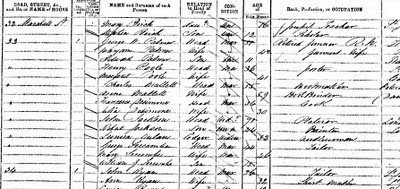Whilst reading my copy of ‘Your Family Tree’ magazine, I came across a great resource for people with London ancestors. The David Rumsey Historical Map Collection includes an 1843 London map which you can transpose over google’s current satellite map. This would have saved me a lot of time a couple of years ago.
I don’t have many links to London in my tree. The only significant person in my tree to reside in London was George Wright PALMER and part of his family.
George was born in Portsea and his job in the Royal Navy caused him to move around a bit. For some reason, George was in London at the time of the 1871 census. He was living at 33 Marshall St with his first wife, Mary Ann and youngest son, Edward.


Here is a photograph I took of what I believe to be 33 Marshall St (I found it the hard way but using this map overlay it was so quick and simple):

Here is a picture I found of 33 – 36 Marshall St, taken in the 1960s (annoyingly from the opposite direction to my picture):

It’s hard to say how long George and his reduced family lived at this address. Mary Ann died the next year and he married his second wife, Emily Jane FELLA in 1873. Tragically, she died just two years later.
I’m not often able to find detailed information on the houses in which my ancestors lived, which makes the details I found at British History Online even more special:
Most of these buildings […] were erected in the 1820’s by or under the supervision of Thomas Finden after the closure of Carnaby Market […]. This redevelopment was uniformly planned, small in area and scale, but forming to-day an unusually pleasant oasis for pedestrians, and offering facilities for shopping away from the through streets. There is accommodation for shop-keepers over the shops, as well as for chamber trades such as tailoring. The least altered parts are the block bounded on the west by Newburgh Street and on the south by Ganton Street, and the two pedestrian courts west of Newburgh Street—Lowndes Court and Marlborough Court.
The prevailing form was the four-storey terrace house fronted in stock brick, two windows wide with plain window-openings, and a continuous plain parapet with stone coping. The windows, most of which have their original narrow glazing-bars, have stone sills. The ground floors were built as shops from the beginning, for this was the period of the planned shopping street…
The ground floors of Nos. 33–36 Marshall Street have thin pilaster-strips and a continuous entablature; space appears to have been provided for shop-windows but, except at No. 35, these spaces have only one domestic-size window each. The ground floors of Nos. 20–22 Peter Street are similar.(From: ‘Marshall Street Area’, Survey of London: volumes 31 and 32: St James Westminster, Part 2 (1963), pp. 196-208. via British-History.ac.uk (Date accessed: 10 Jan 2010).
[Bold font added for ease of reference]
Read 2nd part here.




